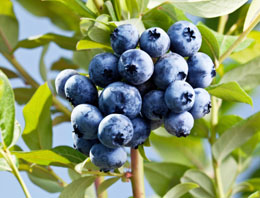A huckleberry plant grows well in moist, acidic soil, and requires long daylight conditions for maximum bearing of fruits. Here is some information and tips on how to grow healthy blossoming huckleberry plants.

Huckleberries are edible fruits of the family
Ericaceae. In some regions, the
Vaccinium species of this family is referred to as the red Huckleberry, whereas other related species are called blueberries. As for huckleberry vs. blueberry, the former can be differentiated from the latter by its large seeds. The fruit is small (about 5 - 10 mm) and color is either bright red or dark purple, depending on the species. Huckleberry is considered as the state fruit of Idaho.
Almost all parts of the plant are useful. The barks are used as a natural remedy for cold and leaves are used in preparing herbal tea. Usually, they are consumed as fresh fruits. They are also excellent for making jams, jellies, sauces, and dried fruits. In spite of the advanced techniques in agriculture, commercial production of huckleberries is still not possible. It is mainly because of the specific conditions required for growing the plant. Mostly, they grow wild in forests and alpine areas. Let's discuss in brief about the techniques for successful process of growing huckleberries.
Tips on How to Grow Huckleberries
Since huckleberries are not cultivated commercially, it is very difficult to find them in markets. Usually, they are available in frozen packages in local farmers' market or in areas where the plants flourish in the wild conditions. Considering this, if you want to taste garden-fresh huckleberries, then you can plant them in your garden. Growing huckleberries is as easy as growing other fruits, provided you follow certain requirement conditions.
Soil Conditions
In late winter, prepare the soil for the plantation of the plant. The plants should not be exposed to extreme frost conditions. Hence, if there are chances of frost, you can start indoors. The soil should be treated properly for prevention of any soil-borne diseases. Since huckleberry plants thrive well in acidic range, check the pH of the soil and make sure it's between 4.5 - 6. Moisten the soil before plantation of huckleberry. Once you have prepared the soil, you can purchase huckleberry plantlets from a reliable source.
Irrigation and Mulching
Plant the plantlets like you do for other fruits. In the first few weeks, you should water the plants daily. If you have started indoors, you can transplant the huckleberry plant in vegetable garden, once frost is over. You can follow mulching so as to restore soil moisture and control weeds. Mulching is also advantageous for proper maintenance of the plants. Like other plants, effective irrigation is essential for growing huckleberries. The plants should be watered regularly for better growth and also to protect them from plant diseases.
Pest and Disease Prevention
Huckleberry plants cannot tolerate root disturbances. Watch out for any diseases and pests. One of the most common huckleberry pests is potato beetles. If you notice any diseases or pests, you can make use of mild pesticides. However, do not use pesticides when the plants start bearing fruits. Depending upon the elevation and other conditions, huckleberry plants bloom any time between the month of May and July. The flowers are short-lived and are of insect pollination type. The warmer the climate during blooming season, higher is the chance of pollination by insects. Contrary to this, a cold climatic condition may result in low huckleberry production.
Harvesting huckleberries is done at the fall, before frost. You can hand-pick the berries when they turn dark purple. Growing huckleberries is quite satisfying; especially after you harvest and enjoy the garden-fresh berries. You can store the fruits for winter season, either by refrigerating them or as dried fruits.






 Huckleberries are edible fruits of the family Ericaceae. In some regions, the Vaccinium species of this family is referred to as the red Huckleberry, whereas other related species are called blueberries. As for huckleberry vs. blueberry, the former can be differentiated from the latter by its large seeds. The fruit is small (about 5 - 10 mm) and color is either bright red or dark purple, depending on the species. Huckleberry is considered as the state fruit of Idaho.
Huckleberries are edible fruits of the family Ericaceae. In some regions, the Vaccinium species of this family is referred to as the red Huckleberry, whereas other related species are called blueberries. As for huckleberry vs. blueberry, the former can be differentiated from the latter by its large seeds. The fruit is small (about 5 - 10 mm) and color is either bright red or dark purple, depending on the species. Huckleberry is considered as the state fruit of Idaho.